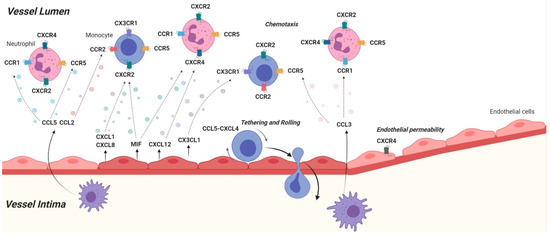Selin Gencer, Bryce R. Evans, Emiel P.C. van der Vorst, Yvonne Döring and Christian Weber
Cells 2021, 10, 226. https://doi.org/10.3390/cells10020226
Atherosclerosis is a long-term, chronic inflammatory disease of the vessel wall leading to the
formation of occlusive or rupture-prone lesions in large arteries. Complications of atherosclerosis can
become severe and lead to cardiovascular diseases (CVD) with lethal consequences. During the last
three decades, chemokines and their receptors earned great attention in the research of atherosclerosis
as they play a key role in development and progression of atherosclerotic lesions. They orchestrate
activation, recruitment, and infiltration of immune cells and subsequent phenotypic changes, e.g.,
increased uptake of oxidized low-density lipoprotein (oxLDL) by macrophages, promoting the
development of foam cells, a key feature developing plaques. In addition, chemokines and their
receptors maintain homing of adaptive immune cells but also drive pro-atherosclerotic leukocyte
responses. Recently, specific targeting, e.g., by applying cell specific knock out models have shed
new light on their functions in chronic vascular inflammation. This article reviews recent findings on
the role of immunomodulatory chemokines in the development of atherosclerosis and their potential
for targeting.

Tagler: Hiç etiket yok
Comments:  (0)
(0)
Henüz yorum yapılmamış